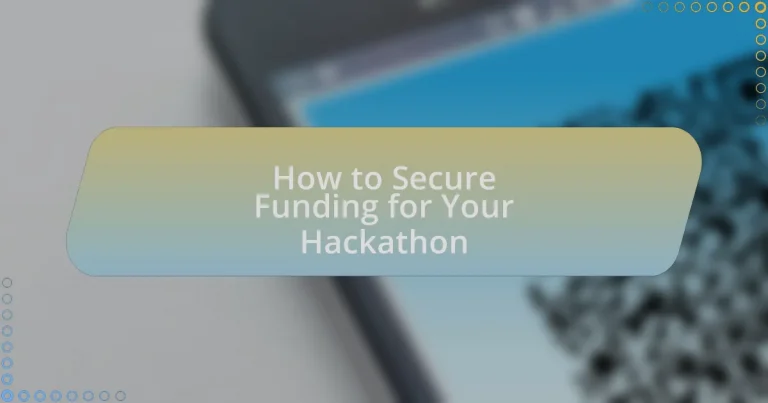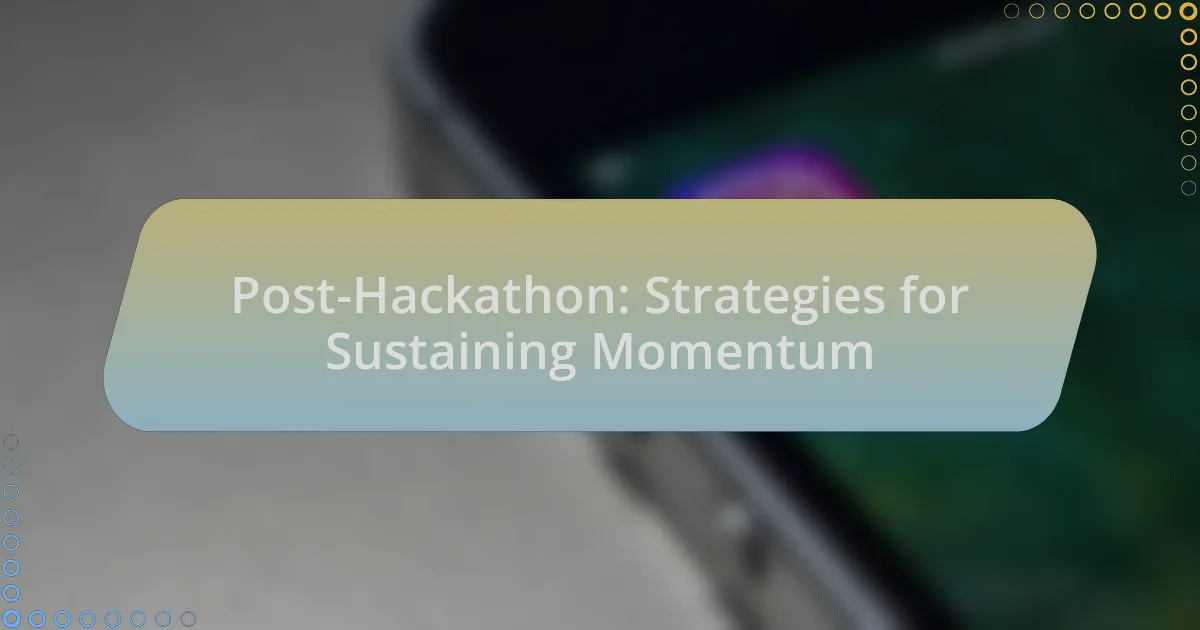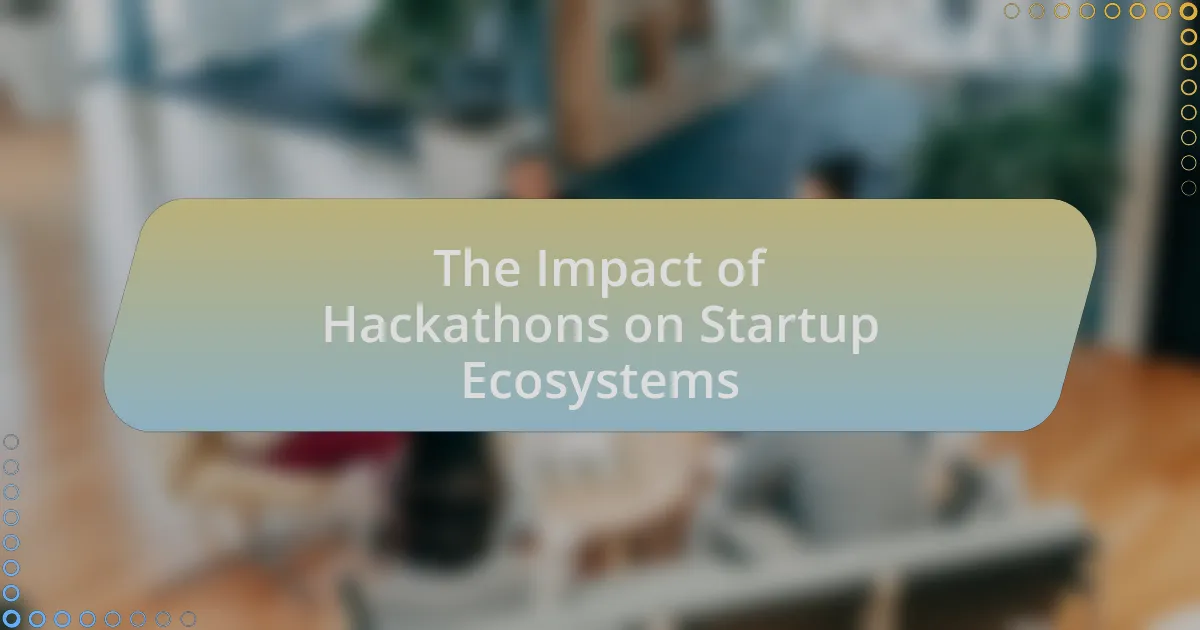The article focuses on the essential steps to secure funding for a hackathon, emphasizing the importance of identifying potential sponsors, creating a compelling sponsorship proposal, establishing a budget, and leveraging community engagement. It outlines strategies for approaching sponsors, the types of organizations that typically provide funding, and the significance of a well-defined budget. Additionally, the article addresses common challenges in securing funding, how to overcome sponsor objections, and alternative funding sources such as crowdfunding and local business partnerships. Key metrics to showcase to potential sponsors and best practices for maintaining long-term relationships are also discussed, providing a comprehensive guide for hackathon organizers seeking financial support.
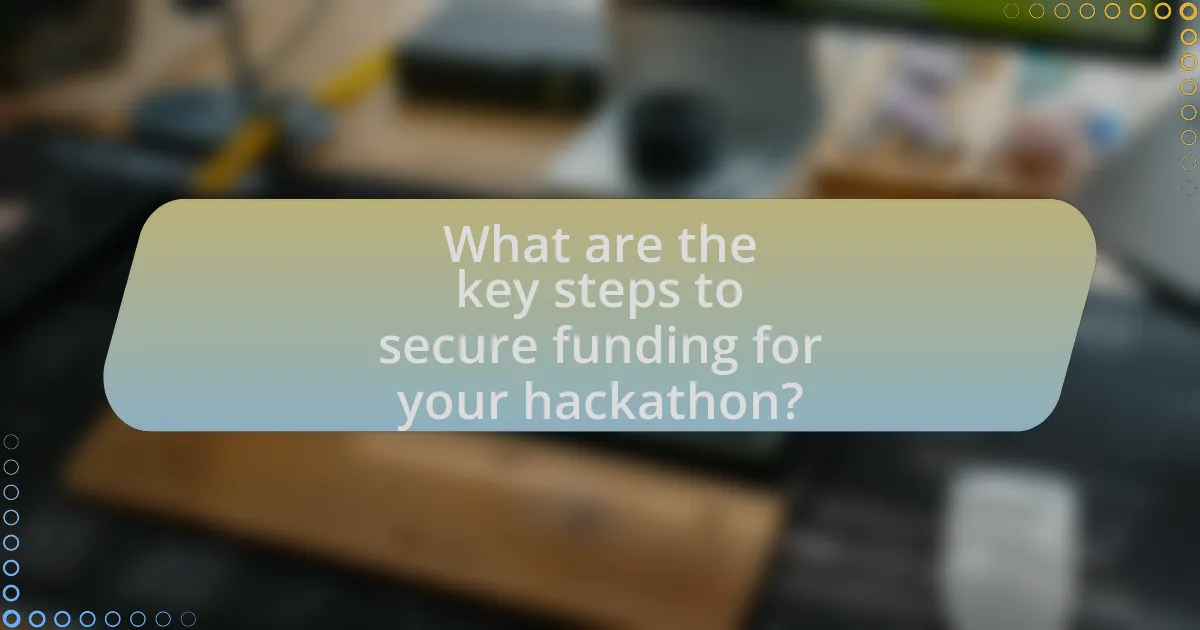
What are the key steps to secure funding for your hackathon?
To secure funding for your hackathon, you should follow these key steps: identify potential sponsors, create a compelling sponsorship proposal, establish a budget, and leverage community engagement. Identifying potential sponsors involves researching companies that align with your hackathon’s theme and values, which increases the likelihood of their support. A compelling sponsorship proposal should clearly outline the benefits for sponsors, such as brand visibility and access to talent, backed by statistics showing the impact of previous events. Establishing a budget helps in determining the funding needed and demonstrates financial responsibility to potential sponsors. Lastly, leveraging community engagement through social media and local partnerships can enhance visibility and attract sponsors who value community involvement.
How do you identify potential funding sources for your hackathon?
To identify potential funding sources for your hackathon, start by researching local businesses, tech companies, and educational institutions that may have an interest in supporting innovation and community engagement. These entities often seek opportunities to enhance their brand visibility and connect with talent. For instance, companies like Google and Microsoft frequently sponsor tech events to foster community relations and talent acquisition. Additionally, explore grant opportunities from organizations like the National Science Foundation, which funds educational initiatives, or local government programs that support community development. Engaging with online platforms such as Sponsorship.com can also provide insights into potential sponsors actively looking to support events like hackathons.
What types of organizations typically sponsor hackathons?
Technology companies, educational institutions, and non-profit organizations typically sponsor hackathons. Technology companies, such as Google and Microsoft, often seek innovative solutions and talent, while educational institutions, like universities, aim to foster student engagement and skill development. Non-profit organizations may sponsor hackathons to address social issues or promote community engagement. These organizations recognize the value of hackathons in driving innovation and collaboration, making them ideal sponsors.
How can you leverage local businesses for funding?
You can leverage local businesses for funding by creating mutually beneficial partnerships that align their marketing goals with your hackathon’s objectives. Local businesses often seek community engagement and visibility, which can be achieved through sponsorship opportunities, such as branding at the event, promotional materials, or co-hosting workshops. According to a study by the Small Business Administration, 70% of small businesses engage in community sponsorships to enhance their brand image and customer loyalty. By presenting a clear value proposition that highlights how their support can lead to increased exposure and customer engagement, you can effectively secure funding from local businesses.
What strategies can you use to approach sponsors effectively?
To approach sponsors effectively, tailor your pitch to align with their business goals and values. Research potential sponsors to understand their target audience, marketing strategies, and previous sponsorships, which allows you to present a compelling case for how your hackathon can benefit them. For instance, if a tech company has sponsored innovation events in the past, emphasize how your hackathon fosters creativity and showcases new talent, directly appealing to their interests. Additionally, provide clear metrics on audience reach and engagement, as sponsors often seek measurable outcomes to justify their investment.
How do you create a compelling sponsorship proposal?
To create a compelling sponsorship proposal, clearly outline the benefits for the sponsor, including visibility, audience engagement, and alignment with their brand values. A well-structured proposal should include an introduction to the event, detailed information about the target audience, sponsorship tiers with corresponding benefits, and a call to action. Research shows that proposals that emphasize mutual benefits and provide specific metrics, such as expected attendance and demographic data, are more likely to secure funding. For instance, a study by the Event Marketing Institute found that 84% of sponsors prioritize audience engagement when considering sponsorship opportunities.
What key elements should be included in your pitch to sponsors?
A successful pitch to sponsors should include a clear value proposition, target audience details, sponsorship benefits, budget outline, and a call to action. The value proposition articulates what makes the hackathon unique and why sponsors should be interested. Providing details about the target audience, such as demographics and expected attendance, helps sponsors understand their potential reach. Clearly outlining the benefits for sponsors, including brand visibility and engagement opportunities, demonstrates the return on investment. A budget outline shows transparency and how funds will be allocated, which builds trust. Finally, a strong call to action encourages sponsors to commit. These elements collectively create a compelling case for sponsorship, increasing the likelihood of securing funding.
Why is it important to establish a budget for your hackathon?
Establishing a budget for your hackathon is crucial because it provides a clear financial framework that guides all planning and resource allocation. A well-defined budget helps organizers identify necessary expenses, such as venue costs, materials, and prizes, ensuring that all aspects of the event are adequately funded. Furthermore, it allows for effective tracking of expenditures against the available funding, which is essential for maintaining financial control and avoiding overspending. According to a study by the National Association of College and University Business Officers, institutions that implement detailed budgeting processes report a 20% increase in event success rates, highlighting the importance of financial planning in achieving desired outcomes.
What are the essential components of a hackathon budget?
The essential components of a hackathon budget include venue costs, catering expenses, technology and equipment fees, marketing and promotional costs, prizes for participants, and staffing or volunteer expenses. Venue costs typically encompass rental fees for the space where the hackathon will be held, while catering expenses cover food and beverages for participants. Technology and equipment fees involve costs for necessary hardware, software licenses, and internet access. Marketing and promotional costs are associated with advertising the event and attracting participants. Prizes for participants incentivize engagement and creativity, and staffing or volunteer expenses account for any personnel needed to manage the event. Each of these components is critical for ensuring a well-organized and successful hackathon.
How can you estimate costs accurately for your event?
To estimate costs accurately for your event, create a detailed budget that includes all potential expenses such as venue rental, catering, equipment, marketing, and staffing. Break down each category into specific line items to ensure no costs are overlooked. Research industry standards and gather quotes from vendors to validate your estimates; for example, a survey by Eventbrite indicates that venues typically account for 30% of total event costs. Additionally, consider including a contingency fund of 10-15% to cover unexpected expenses, as unforeseen costs can arise in any event planning process.
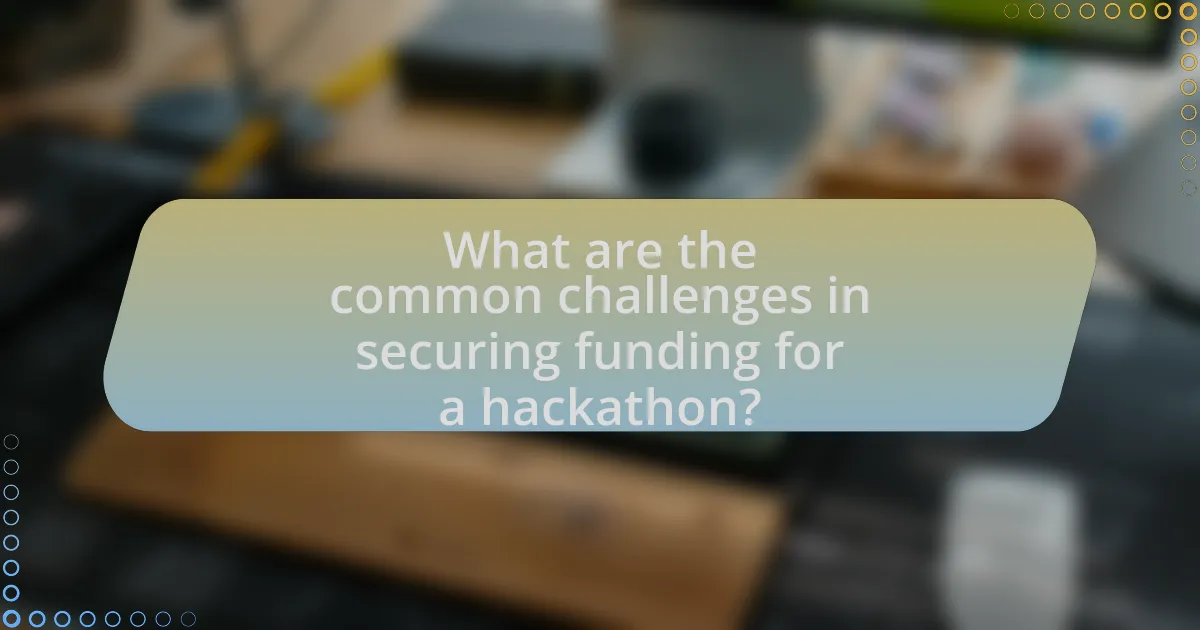
What are the common challenges in securing funding for a hackathon?
Common challenges in securing funding for a hackathon include a lack of clear sponsorship value propositions, difficulty in identifying potential sponsors, and competition from other events for limited resources. Sponsors often require a compelling reason to invest, which necessitates a well-defined value proposition that outlines the benefits they will receive, such as brand exposure or access to talent. Additionally, organizers may struggle to pinpoint companies that align with the hackathon’s theme or target audience, making it harder to secure commitments. Furthermore, many hackathons compete for the same pool of sponsors, leading to challenges in differentiating their event and convincing sponsors to allocate funds.
How can you overcome objections from potential sponsors?
To overcome objections from potential sponsors, clearly address their concerns with tailored solutions and evidence of past success. For instance, if a sponsor is worried about visibility, present data showing how previous events increased brand exposure, such as a 30% rise in social media engagement or attendance metrics. Additionally, offer flexible sponsorship packages that align with their marketing goals, demonstrating adaptability to their needs. Engaging in open dialogue to understand their hesitations allows for a more personalized approach, which can lead to a stronger partnership.
What are the most frequent concerns sponsors have about funding hackathons?
Sponsors frequently express concerns about the return on investment (ROI) when funding hackathons. They worry that the resources allocated may not yield sufficient visibility or engagement with their target audience. Additionally, sponsors often question the quality of the participants and the projects produced, fearing that the outcomes may not align with their brand values or objectives. Concerns about logistical challenges, such as event management and participant turnout, also arise, as sponsors seek assurance that the hackathon will be well-organized and attract a competitive pool of talent.
How can you address these concerns in your communications?
To address concerns in your communications regarding securing funding for your hackathon, clearly articulate the value proposition of the event. This involves detailing the benefits for sponsors, such as brand visibility, access to talent, and community engagement. For instance, research shows that 70% of sponsors value direct engagement with participants, which can enhance their recruitment efforts. Additionally, provide transparent budget breakdowns and demonstrate how funds will be utilized effectively, reinforcing trust and accountability. By presenting data and testimonials from past events, you can further validate the impact and success of the hackathon, making a compelling case for potential sponsors.
What alternatives exist if traditional funding sources are unavailable?
If traditional funding sources are unavailable, alternatives include crowdfunding, sponsorship from local businesses, and grants from non-profit organizations. Crowdfunding platforms like Kickstarter or GoFundMe allow individuals to raise small amounts of money from a large number of people, which can be effective for hackathons. Local businesses may provide sponsorship in exchange for advertising opportunities, helping to cover costs while promoting their brand. Additionally, non-profit organizations often offer grants specifically aimed at supporting community events, including hackathons, which can provide necessary funding without the need for traditional financial institutions.
How can crowdfunding be utilized to finance your hackathon?
Crowdfunding can be utilized to finance your hackathon by creating a campaign on platforms like Kickstarter or Indiegogo, where you can present your event’s goals and attract backers. This approach allows you to reach a wide audience, leveraging social media and community networks to promote the campaign and encourage contributions. Successful crowdfunding campaigns often include incentives for backers, such as exclusive merchandise or recognition at the event, which can motivate individuals and organizations to support your hackathon financially. According to a study by the University of Pennsylvania, crowdfunding campaigns that effectively communicate their mission and engage with potential backers can raise significantly more funds, demonstrating the effectiveness of this financing method.
What role do ticket sales play in funding your event?
Ticket sales are a primary source of funding for events, including hackathons. They generate revenue that can cover venue costs, materials, and other operational expenses. For instance, if a hackathon sells 200 tickets at $50 each, it raises $10,000, which can significantly contribute to the overall budget. This revenue stream is crucial, as it not only supports the event’s financial viability but also reflects participant interest and engagement, which can attract additional sponsors and partnerships.
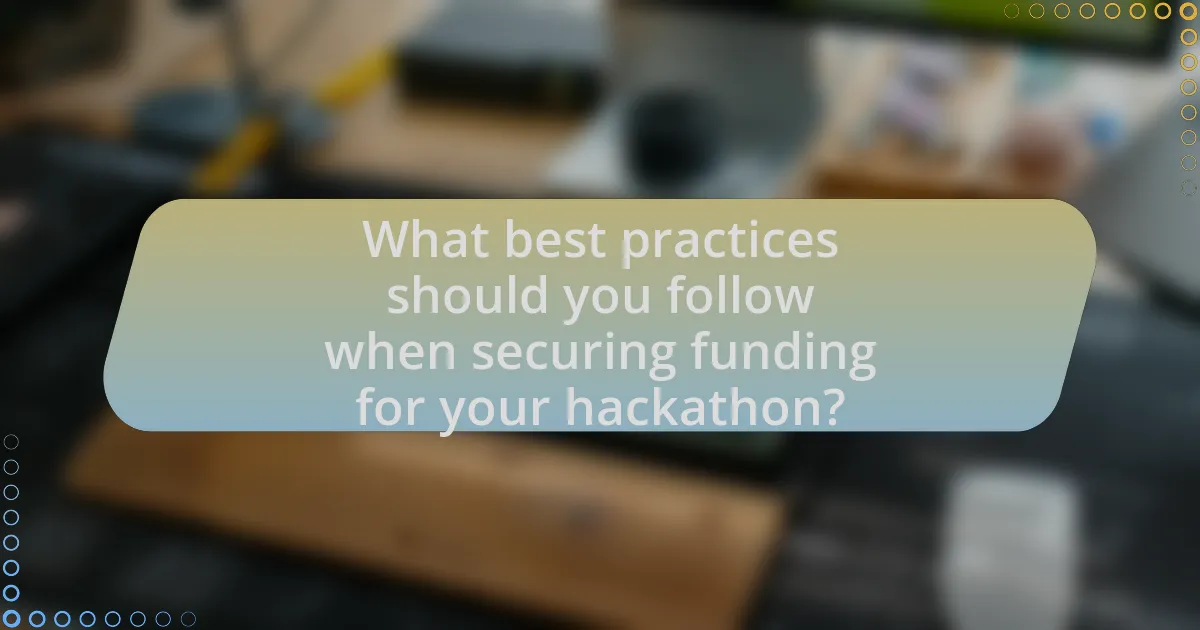
What best practices should you follow when securing funding for your hackathon?
To secure funding for your hackathon, establish a clear budget and articulate the value proposition to potential sponsors. A well-defined budget outlines all expenses, including venue, materials, and prizes, which helps in identifying the total funding needed. Articulating the value proposition involves demonstrating how sponsoring the hackathon can benefit companies, such as brand exposure, talent acquisition, and community engagement. According to a study by the Event Marketing Institute, 84% of participants in sponsored events feel more positively about the brand, reinforcing the importance of a compelling pitch to attract sponsors.
How can you build long-term relationships with sponsors?
To build long-term relationships with sponsors, consistently deliver value and maintain open communication. Establishing trust through transparency about goals and expectations fosters a collaborative environment. Regularly updating sponsors on event progress and outcomes demonstrates accountability and appreciation for their support. Additionally, creating opportunities for sponsors to engage with participants, such as through networking events or feedback sessions, enhances their investment in the relationship. Research indicates that organizations that prioritize relationship management see a 20% increase in sponsor retention rates, highlighting the importance of sustained engagement and mutual benefit.
What follow-up strategies are effective after securing funding?
Effective follow-up strategies after securing funding include maintaining clear communication with funders, providing regular updates on project progress, and demonstrating accountability through transparent financial reporting. Clear communication fosters trust and keeps funders engaged, while regular updates, such as monthly reports or newsletters, inform them about milestones and achievements. Additionally, transparent financial reporting, which includes detailed breakdowns of how funds are utilized, reassures funders that their investment is being managed responsibly. These strategies are supported by research indicating that consistent engagement and accountability can enhance long-term relationships with funders, ultimately leading to potential future funding opportunities.
How can you keep sponsors engaged during and after the event?
To keep sponsors engaged during and after the event, maintain consistent communication and provide value through tailored experiences. Engaging sponsors during the event can be achieved by offering them opportunities for visibility, such as branded spaces, speaking slots, and interactive sessions that highlight their contributions. After the event, follow up with personalized thank-you messages, share event highlights, and provide data on their sponsorship impact, such as attendee engagement metrics and feedback. Research shows that 70% of sponsors appreciate post-event reports, which reinforces their investment and encourages future collaboration.
What tips can help you maximize your funding efforts?
To maximize your funding efforts for a hackathon, focus on building strong relationships with potential sponsors and clearly articulating the value of your event. Engaging with sponsors through personalized outreach and demonstrating how their support aligns with their marketing goals can significantly enhance funding opportunities. For instance, a study by the Nonprofit Finance Fund found that organizations that maintain ongoing communication with funders are 50% more likely to secure repeat funding. Additionally, creating a detailed sponsorship proposal that outlines audience demographics, event reach, and potential ROI can effectively persuade sponsors to invest.
How can you effectively promote your hackathon to attract sponsors?
To effectively promote your hackathon and attract sponsors, create a targeted marketing strategy that highlights the event’s unique value proposition and audience engagement potential. Utilize social media platforms, email campaigns, and partnerships with tech communities to reach potential sponsors. For instance, showcasing past success stories, participant demographics, and media coverage can demonstrate the hackathon’s impact and visibility. According to a study by Eventbrite, 70% of sponsors prefer events that have a clear audience and measurable outcomes, reinforcing the importance of presenting data that illustrates the hackathon’s reach and engagement.
What are the key metrics to showcase to potential sponsors?
The key metrics to showcase to potential sponsors include audience reach, engagement rates, demographic data, and past event performance. Audience reach quantifies the number of participants and attendees, which can be demonstrated through registration numbers and social media followers. Engagement rates reflect how actively participants interact with the event, often measured by social media interactions, website visits, and email open rates. Demographic data provides insights into the target audience’s age, location, and interests, helping sponsors understand their market alignment. Past event performance can be illustrated through success stories, testimonials, and metrics such as participant satisfaction scores and return on investment from previous sponsors. These metrics collectively provide a compelling case for sponsorship by demonstrating the event’s potential impact and alignment with sponsor goals.
